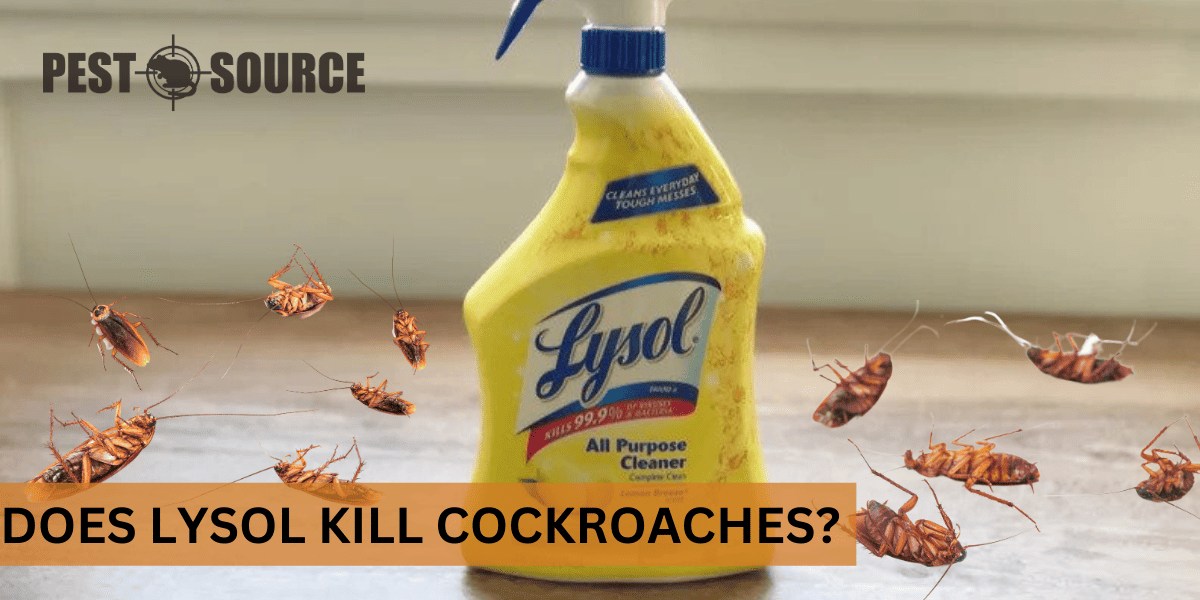Lysol can kill cockroaches on contact, as it contains ingredients that are toxic to these insects. Read on to learn about the effectiveness of Lysol against roaches and how to use it safely in your home.
POINTS
- Lysol can kill cockroaches on contact due to its alcohol content but is not an effective solution for cockroach infestations as it does not have residual effects to prevent future infestations.
- Household cleaning agents, including hydrogen peroxide and hand sanitizer, may kill cockroaches on contact but are not designed for pest control and lack long-term efficacy.
- Lysol has no long-term repellent effects on cockroaches and does not affect cockroach eggs, which are protected by a hard casing resistant to many chemicals.
- Using Lysol as a pest control method poses potential health risks to humans and pets and can have environmental impacts due to its chemical content.
- Alternative methods such as baits, traps, insect growth regulators, and professional pest control services, along with natural alternatives and preventive measures, are more effective and safer for controlling cockroach infestations.
The Efficacy of Lysol as a Cockroach Killer
When it comes to dealing with cockroaches, homeowners often reach for what’s readily available, and Lysol is a common household item. Lysol is known primarily as a disinfectant, but many wonder about its efficacy in killing cockroaches. Let’s examine the components of Lysol and assess its potential as a cockroach killer.
Chemical Components of Lysol and Their Impact on Cockroaches
Lysol contains several chemical ingredients, with the main ones being ethanol/SD Alcohol, which is a solvent, and benzalkonium chloride, which is a disinfectant. These ingredients are effective in killing bacteria and viruses, but their impact on cockroaches is a different story.
Cockroaches are hardy insects, and while the chemicals in Lysol can be harmful to them, the product is not designed specifically to target pests. Spraying cockroaches directly with Lysol may kill them due to the alcohol content, which can act as a toxin. However, it is not the most efficient or recommended method for cockroach control.
Scientific Studies on Lysol’s Effectiveness Against Cockroaches
There is limited scientific research specifically on the use of Lysol to kill cockroaches. Most studies focus on insecticides designed for pest control. However, expert opinions suggest that while Lysol can be lethal to cockroaches if sprayed directly, it is not a viable solution for an infestation. This is because it does not have residual effects that continue to kill roaches after application.
Is Lysol a Viable Solution for Cockroach Infestations?
The short answer is no. Lysol is not a viable solution for cockroach infestations. Although it may kill on contact, it does not contain the necessary ingredients to effectively eliminate a cockroach population. For a lasting solution, it’s better to use products specifically formulated for cockroach control.
Comparison with Other Disinfectants and Cleaning Agents
When comparing Lysol to other disinfectants like hydrogen peroxide or cleaning sprays, it’s important to understand how these products work against cockroaches.
Impact of Household Cleaning Agents on Roaches
Household cleaning agents, including hydrogen peroxide and hand sanitizer, may have some impact on roaches, primarily if used directly. Like Lysol, the high alcohol content in hand sanitizer can kill roaches on contact. Hydrogen peroxide, less toxic than other chemicals, has oxidizing properties that could theoretically harm cockroaches. However, as with Lysol, these products are not designed for pest control and have no residual effects to prevent future infestations.
Role of Chemicals in Products Against Cockroaches
The chemicals in disinfectants and cleaning agents act as poisons or suffocating agents when they come into direct contact with cockroaches. However, their primary design is for sanitizing surfaces and not for long-term pest control. Effective cockroach control typically requires insecticides that have residual killing power and are specifically labeled for roach control.
The Immediate and Long-Term Effects of Lysol on Roaches
Understanding the immediate and long-term effects of Lysol on roaches is crucial for homeowners considering it as a pest control option.
How Quickly Lysol Affects Cockroaches
When directly sprayed, Lysol can kill cockroaches fairly quickly due to the toxic effects of its alcohol content. However, the speed of its effectiveness can vary based on the size of the roach and how much of the product is sprayed.
Long-Term Repellent Effects of Lysol
Lysol does not have long-term repellent effects on cockroaches. After the spray settles and dries, it loses its potency against pests. Cockroaches are likely to return unless a proper pest control method is used.
Impact of Lysol on Cockroach Eggs
Lysol has no known effect on cockroach eggs. These eggs are protected by a hard casing called an ootheca, which is resistant to many types of chemicals. To prevent future infestations, it’s essential to target the eggs with specific insecticides or methods recommended by pest control professionals.
Lysol’s Impact on Different Types of Insects and Pests
While Lysol’s primary use is for disinfection and cleaning, it’s natural to wonder about its broader pest control capabilities. Let’s delve into its effects on a variety of household pests.
Effectiveness of Lysol Against Various Household Insects
Lysol’s insecticidal properties are not comprehensive or reliable when it comes to a range of household pests. Although direct contact with Lysol can be lethal to insects like ants and stink bugs, similar to cockroaches, it does not provide a long-term solution. Insects can recover if not directly sprayed or if the product has dried.
Can Lysol Repel or Kill Insects Besides Cockroaches?
Lysol is not an insect repellent. It lacks the necessary properties to deter insects over time. While it might kill some insects on contact, they do not perceive it as a threat once it has evaporated, making it ineffective as a repellent or long-term solution for infestations.
Safety and Environmental Considerations When Using Lysol Against Cockroaches
Using Lysol as a pest control method comes with safety and environmental concerns that should not be overlooked.
Potential Risks to Humans and Pets
Lysol contains chemicals that can be harmful if inhaled or ingested by humans or pets. It is crucial to use it in well-ventilated areas and to follow the manufacturer’s safety instructions. Overuse or improper application can lead to respiratory issues or other health problems.
Environmental Impact of Using Chemical Sprays for Pest Control
Chemical sprays, including Lysol, can contribute to environmental pollution. They may contaminate surfaces, air, and water sources, and have detrimental effects on non-target organisms. It’s important to consider the environmental footprint when using chemical sprays for pest control.
Guidelines for Safe and Effective Use
To use Lysol safely and effectively in a household setting, consider the following guidelines:
- Always read and follow label instructions.
- Use in well-ventilated areas to minimize inhalation risks.
- Avoid spraying near food, children’s toys, or pet areas.
- Consider using Lysol for its intended purpose – disinfection – rather than pest control.
Alternative Methods and Preventive Measures for Cockroach Control
For those seeking other methods to control and prevent cockroach infestations, there are several effective strategies.
Effective Cockroach Control Methods
- Baits and Traps: These are specifically designed to attract and kill cockroaches, often containing slow-acting insecticides that cockroaches can carry back to their nests.
- Insect Growth Regulators (IGRs): These chemicals disrupt the growth and reproduction of cockroaches, preventing them from reaching maturity or reproducing.
- Professional Pest Control Services: Experts can provide targeted treatments that are more effective and long-lasting than DIY methods.
Natural and Less Harmful Alternatives
- Diatomaceous Earth: A non-toxic powder that can dehydrate and kill cockroaches when they crawl over it.
- Boric Acid: A substance that, when used correctly, can be a potent cockroach killer while being less toxic to humans and pets.
- Essential Oils: Some oils, like peppermint, may have a repellent effect on cockroaches, although they are not as effective as professional treatments.
Tips for a Cockroach-Free Environment
- Maintain Cleanliness: Regularly clean your home, especially the kitchen, to remove food residues and spills that attract cockroaches.
- Seal Entry Points: Close gaps around doors, windows, and pipes to prevent cockroaches from entering.
- Manage Trash and Compost: Keep trash and compost in sealed containers and dispose of them regularly.
Does Bleach Kill Cockroaches?
Bleach can kill cockroaches through its corrosive effect, which is lethal to these pests when ingested or directly contacted. When used as a cleaning agent, bleach’s strong disinfectant properties can destroy germs that attract cockroaches, reducing their food sources. However, simply spraying bleach around is not an effective method for cockroach control, as it may not reach them in their hiding places and can pose risks to human health and safety if not handled properly.



